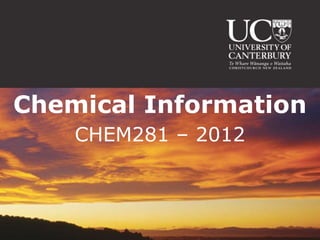
CHEM281 2012
- 1. Chemical Information CHEM281 – 2012
- 2. We are aiming at… Finding reliable (and recent) information sources Finding a paper by specific authors Finding review articles on particular subjects like biochemicals Finding information for compounds – formulas, structures, toxicity Finding out about enzymes – EC numbers Using Google Scholar Find out how often a paper has been cited Formatting a bibliography in the ACS citation style
- 3. You already know (I expect)… Journals have articles relating to the journal topic A review article sums up other articles written on a subject Citing = listing what you have read as research or background References (in-text and at end) are used when the author is Quoting; or Referring to facts
- 4. Some may already know… APA-style referencing How to find papers Google Scholar Scopus Lecturers’ papers department website How to locate chemical data Merck Index, etc.
- 5. But we need to know more about… How to find reliable sources Articles References Review articles Chemical data, EC numbers etc. Citation counts How much has an article been cited? How to reference properly ACS citation style
- 6. Today we will look at… 1. How scientists share information 2. Finding chemical and/or enzyme data 3. Structure drawing (briefly) 4. Finding papers 5. Referencing sources in ACS style
- 7. Some ways you could share your results Give talks Write them down and send to a friend Send letters or newsletters Publish in newspapers Publish independently – get in touch with a printing press to publish papers or books Gather articles about the same subject and send out a journal
- 8. Journals “Magazines” for scientists Narrow subject focus New issues without end, often regular (quarterly, monthly etc.) Each issue has articles by a various authors about their research
- 9. How could hoaxes be prevented? Repeat the experiment; same results? Check the author’s credentials Employ experts in the subject to edit journals Check ideas against previously published information Peer review by other experts
- 10. Peer review Article sent to peers = scientists working in the same field Peers review the article to check Accuracy Clarity Reproducibility Author makes corrections and improvements Publication
- 11. Balancing access… Put journals in a search engine Easy to find Big companies manage databases Articles from many journals all in one place Articles could be free to view…
- 12. … and profit Charge institutions Subscription fees or pay-per-article Free preview, pay for the full article Free to view, funded by: advertising research grants donations government universities
- 13. Databases By publisher vs by subject Full-text vs citation only Articles vs data Precision vs usability Pay-for vs free No single one has it all!
- 14. So where to start? http://canterbury.libguides.com/chem
- 15. handling and storage hazard ratings accidental release measures toxicological data properties
- 16. reactions EC numbers organisms inhibitors substrates properties references
- 17. (1) properties formula structure drawing weight & much, much links to some more data... articles/patents
- 18. (2)
- 19. journal review articles articles links to full text (if we have it) Who has cited whom
- 20. How would you… cite an article? Authors Title of the paper Where it was published – Journal name Year published Volume Issue Page numbers
- 21. Analysis of a reference Colak, A. T.; Colak, F.; Yesilel, O. Z.; Buyukgungor, O. Synthesis, spectroscopic, thermal, voltammetri c studies and biological activity of crystalline complexes of pyridine-2,6-dicarboxylic acid and 8-hydroxyquinoline. J. Mol. Struct. 2009, 936 (1-3), 67-74.
- 22. Summing Up (1) Chemistry Subject Guide “How do I find?” Chemical data Journal articles Material Safety Data Sheets Citation guide (ACS)
- 23. Summing Up (1) For reliable sources search in databases that collect peer-reviewed journals SciFinder, Web of Science, Scopus, Google Scholar Specialist databases: BRENDA for enzymes and EC numbers ChemWatch for hazards and material safety data sheets (MSDS) ChemSpider/ChemSketch for structure, properties, drawing molecules Read the Screen! Author field Refining document type to “Review” for review articles
- 25. Contact me Chat Meet Email